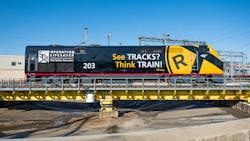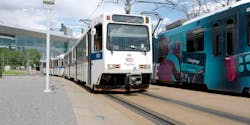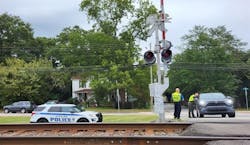Transit agencies, state DOT’s celebrate See Tracks? Think Train® Week
During the week of Sept. 15, transit agencies and state departments of transportation (DOTs) participated in See Tracks? Think Train® Week. Formerly known as Rail Safety Week in the U.S., Operation Lifesaver, Inc. (OLI) launched the campaign in 2017 to focus attention on the importance of making safe choices when driving or walking near railroad tracks and trains.
A week of events
OLI notes the 2025 campaign included a full slate of daily themes tailored to specific audiences. Highlights include:
- Monday, Sept. 15: The week kicked off with #STOPTrackTragedies Media Outreach Day, launching the campaign with proclamations and the release of a new public service announcement (PSA) and video sharing emotional real-life rail incident experiences from OLI.
- Tuesday, Sept. 16: A focus on Operation Clear Track in the U.S. and Canada, emphasizing the importance of obeying crossing safety and anti-trespass laws. Law enforcement and first responders across the U.S. conducted awareness exercises, Officer on the Train activities and other in-person positive enforcement events, as well as sharing rail safety education messages through social media, emails and website posts.
- Wednesday, Sept. 17: Highlighting crossing safety, emphasizing the importance of making safe choices where roadways cross railroad track to include use of the Blue and White Emergency Notification System (ENS) signs.
- Thursday, Sept. 18: Highlighting two areas of emphasis: Transit Safety Thursday and Professional Driver Safety, focusing on safe transit riding habits and sharing roadways with transit trains and critical information for truckers and professional drivers, as well as school bus drivers. On this day, transit riders, friends and family were encouraged to share and take OLI’s Transit Safety Pledge.
- Friday, Sept. 19: Focusing on volunteering with OLI, along with wearing red for "Red Out" for Rail Safety by encouraging partner safety organizations, schools, railroad employees and the public to wear red in support of rail safety education and share photos on social media.
- Saturday, Sept. 20: Trespass Prevention Day, targeting pedestrians, joggers, students and outdoor enthusiasts with safety messages about the dangers of being on or near the tracks.
- Sunday, Sept. 21: The week concludes with messages to the creator community, as well as amateur and professional photographers. No photo, video or selfie is worth the risk warns content creators of the dangers of illegal photos or videos taken near tracks and trains.
“This week is about action, not just awareness,” said OLI Executive Director Rachel Maleh. “We’re empowering people to know the facts, make safe decisions and protect themselves, their families and communities. Together, we can—and must—#STOPTrackTragedies.”
OLI debuts two new public service announcements (PSAs)
To kickstart the week, OLI debuted two PSAs that are designed to promote safe choices for drivers sharing the road with transit trains like streetcars and trolleys, as well as metro and light-rail systems.
According to OLI, the two 30-second video PSAs, Dedicated Left Turn and In-Street Running, present realistic scenarios that underscore the importance of understanding roadway layouts, paying attention to traffic signals and always yielding to trains. The safety messages are part of OLI’s ongoing efforts to reach roadway users in communities with transit systems and help prevent collisions, injuries and fatalities at railroad crossings and along railroad rights-of-way.
“In both of these new PSAs, we see relatable close calls that serve as critical reminders for drivers navigating urban environments with rail transit,” Maleh said. “These engaging spots share essential safety messages that drivers can apply immediately, especially in areas with light rail or streetcar systems operating in-street or adjacent to vehicle traffic.”
Operation Clear Track
On Tuesday, Sept. 16, OLI joined forces with hundreds of Amtrak law enforcement agencies and first responders across the U.S. for Operation Clear Track to reinforce the importance of making safe choices near railroad tracks and trains. Throughout the day, first responders were stationed at targeted railroad grade crossings and other Amtrak locations nationwide, sharing rail safety education message with their communities, distributing rail safety materials and enforcing crossing and trespassing laws.
According to Maleh, “One choice can change everything. Operation Clear Track helps make the safe choice the clear choice. We are proud to partner with Amtrak supporting first responders in this powerful effort to raise awareness and help stop track tragedies before they happen.”
Amtrak Chief of Police D. Samuel Dotson added, “Operation Clear Track helps us engage with communities and reinforce the importance of safety around railroad tracks and crossings. Trespassing on tracks is not only dangerous, but also illegal. By reminding everyone to respect railroad crossings while alerting them to the dangers of trespassing, we can collectively work to reduce tragic accidents and ensure the safety of our families and communities.”
Data from the Federal Railroad Administration (FRA) reveals trespassing along railroad rights-of-way remains the leading cause of rail-related deaths in the U.S., followed by railroad crossing incidents. According to the data, in 2024, more than 2,300 people were injured or killed while trespassing along railroad rights-of-way.
Agencies throughout the U.S. highlight their commitment to rail safety
Many transit agencies have pledged their commitment to improve rail safety during See Tracks? Think Train Week.
Denver Regional Transportation District (RTD)
Denver RTD says some railroad crossings, especially in rural areas of Colorado, may not have gates or signals. Those kinds of railroad crossings are known as passive crossings and require special attention from motorists to stop, look and listen for trains. According to the agency, passive warning crossings lack bells, flashing light, and gates found with active crossings and in urban areas of the state where active warning crossings are more common, Denver RTD released a video on the importance of rail safety.
“[Denver] RTD operates 10 rail lines on more than 114 miles of track throughout the Denver metro region,” said Denver RTD General Manager and CEO Debra A. Johnson. “Across our rail network, the agency’s team carries an awesome responsibility to safely transport the most important thing in life, which is people. The need to conduct oneself in a safe manner around railroad crossings and train tracks is paramount to all customers we serve within the communities our trains travel.”
The agency notes that as of 2024, there are 784 active warning crossings in Colorado and 960 passive warning ones, and that in that same year, 46 crashes involving trains resulted in 24 injuries and one death in the state. In 2025, two people have been killed and five injured in 32 crashes so far, with most of the crashes taking place at crossings with active warnings.
“Whether you’re in a car, on a bike, walking or traveling by any other mode, never try to beat a train,” said Colorado Department of Transportation Executive Director Shoshana Lew. “We remind all travelers to pay attention to the warning signs at railroad crossings and stay on the lookout for trains. These simple steps can be lifesaving.”
Orange County Transportation Authority (OCTA)
OCTA created a safety outreach event in Santa Ana, Calif., where staff and safety partners distributed educational materials and talked directly with passengers about how to prevent rail-related tragedies. According to the agency, the state of California leads the nation in rail-related fatalities, with incidents caused both by trespassing on tracks and collisions at grade crossings.
“This month, we are highlighting our commitment to rail safety, and we want every rider, driver, bicyclist and pedestrian to remember that staying safe near the tracks can save lives,” said OCTA Board Chair and Orange County Fourth District Supervisor Doug Chaffee. “Rail safety is everyone’s responsibility. Through education, outreach and strong partnerships, we continue to make safety our top priority.”
Utah Transit Authority (UTA)
UTA put its focus on what its calling “a simple but powerful reminder: Every Sign Tells a Story.” UTA believes that “Rail safety signs aren’t just symbols; they are lifesavers. Whether you are behind the wheel, on a bike or walking near tracks, each sign is designed to keep you safe”.
UTA Trustee Jeff Acerson says the agency’s main focus for its riders is safety.
“The safety of our riders, operators and people on the road is priority number one at UTA,” Acerson said. “Our partnerships with organizations dedicated to rail safety are crucial to raising awareness and reducing the number of preventable incidents.”
Connecticut Department of Transportation (CTDOT)
CTDOT held a press event at the start of the week at the Wallingford Train Station to raise awareness to reduce collisions between trains and motor vehicles or pedestrians and prevent track tragedies.
“Every life lost on or near the tracks is a devastating tragedy for entire communities,” said CTDOT Deputy Commissioner Laoise King. “With over 600 active rail crossings statewide, we all share the responsibility of staying alert and making safe choices.”
CTDOT notes that across the state in 2024, there were six vehicle–train collisions resulting in two injuries and no fatalities and six pedestrian–train incidents that caused two injuries and four fatalities. According to CTDOT, through Sept. 2, 2025, there have been 12 rail incidents in the state this year, including 10 pedestrian strikes and 10 total fatalities.
In partnership with Connecticut OLI, CTDOT also hosted various See Tracks? Think Train Week events throughout the state during the week.
Brightline
Brightline says its rail safety priorities are focused on education, enforcement and engineering. Throughout See Tracks? Think Train Week, Brightline partnered with Hollywood Police Department, Riveria Beach Police Department, Melbourne Police Department, City of Miami Police Department, Miami-Dade Sheriff’s Department, among other law enforcement agencies up and down the corridor with PSAs, safety demonstrations, flier distributions and enforcement sweeps. Brightline also shared social media posts and the rail safety pledge with local communities.
“Safety is our top priority, paramount to everything we do at Brightline, which is why we continually invest in our communities alongside local partners to educate, support enforcement and identify engineering solutions,” said Brightline Vice President of Operations Michael Lefevre. “We all need to do our part – motorists, pedestrians and community members – to act safely and follow the laws around the tracks.”
Brightline notes that since its inception, it has satisfied or exceeded every safety requirement set forth by the FRA and Florida Department of Transportation. The agency says it has invested nearly $230 million in crossing upgrades, plus $266 million for Positive Train Control.
According to the agency, the intercity rail system has also continued supporting municipalities to apply, receive and implement over $65 million in state and federal grants, including a Consolidated Rail Infrastructure and Safety Improvements Grant to improve 48 crossings in the Tri-County area completed in 2023 and a Rebuilding American Infrastructure with Sustainability and Equity Grant to enhance corridor safety resulting in a $45 million investment.
In partnership with the lead applicant Broward MPO, Brightline partnered with Broward County, local municipalities (Dania Beach, Wilton Manors, Ft. Lauderdale, Hallandale Beach, Hollywood and Pompano Beach) and Florida East Coast Railway in the 2022 Rail Crossing Elimination Program. The project improves 21 crossings by constructing exit gates and/or medians at each location. The FRA has agreed to invest $15.4 million in the project, with an additional $3.86 million in funding from local municipalities, for a total of $19.3 million.
Brightline notes that for over nine years, it has implemented an aggressive safety program that includes tri-lingual materials distributed in schools, at railroad crossings, local businesses and community events. To date, the agency says that over 50,000 individuals have signed the Rail Safety Pledge, promising to be safe around railroad tracks and trains.
Massachusetts Bay Transportation Authority (MBTA)
MBTA partnered with the Massachusetts Department of Transportation, Keolis Commuter Services, MBTA Transit Police and others in a series of educational initiatives in support of the safety campaign.
“While ‘See Track, Think Train’ is a powerful annual campaign, safety needs to be on everyone’s mind every day of the year,” said MBTA General Manager and CEO Phillip Eng. “Through education, engineering and enforcement, we’ve made real progress but there is so much more to do. Grade crossings are safe when rules of the road are followed, whether it is in an automotive vehicle or on foot. Safety starts with awareness, so if you see tracks, always assume a train is coming from either direction and never walk along the tracks or cross the tracks when the lights are flashing and the gates are down. See Track, Think Train: it’s a simple message that saves lives.”
North Carolina Department of Transportation (NCDOT)
On Sept. 16, BeRailSafe, NCDOT’s Rail Division's railroad safety unit, and partner organizations, including the Clayton Police Department, N.C. Operation Lifesaver, Amtrak Police and Norfolk Southern Police, conducted three simultaneous crossing blitzes in Clayton and talked to over 1500 motorists to provide railroad track and crossing safety information.
NCDOT notes the BeRailSafe program provides free rail safety training to police, fire and 911 operators in all 100 counties of the state. Staff with the outreach program also promote rail safety statewide at festivals and events.
"It's critical we get this information to as many people as possible to make them aware of the dangers of unsafe behavior around railroad tracks and crossings," said BeRailSafe Program Coordinator Ain Flowers. “Our number one goal is to save lives by teaching people about railroad track and crossing safety to prevent injuries and fatalities."
About the Author
Brandon Lewis
Associate Editor
Brandon Lewis is a recent graduate of Kent State University with a bachelor’s degree in journalism. Lewis is a former freelance editorial assistant at Vehicle Service Pros in Endeavor Business Media’s Vehicle Repair Group. Lewis brings his knowledge of web managing, copyediting and SEO practices to Mass Transit Magazine as an associate editor. He is also a co-host of the Infrastructure Technology Podcast.






